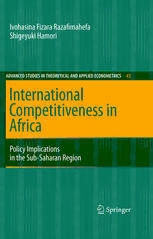
International Competitiveness in Africa: Policy Implications in the Sub-Saharan Region PDF
Preview International Competitiveness in Africa: Policy Implications in the Sub-Saharan Region
Advanced Studies in Theoretical and Applied Econometrics Volume 43 ManagingEditors: J.Marquez,TheFederalReserveBoard,Washington,D.C.,U.S.A A.Spanos,VirginiaPolytechnicInstituteandStateUniversity,Blacksburg,VA, U.S.A EditorialBoard: F.G.Adams,UniversityofPennsylvania,Philadelphia,U.S.A P.Balestra,UniversityofGeneva,Switzerland M.G.Dagenais,UniversityofMontreal,Canada D.Kendrick,UniversityofTexas,Austin,U.S.A J.H.P.Paelinck,NetherlandsEconomicInstitute,Rotterdam,TheNetherlands R.S.Pindyck,SloaneSchoolofManagement,M.I.T.,U.S.A W.Welfe,UniversityofLodz,Poland The titles published in this series are listed at the end of this volume. . Ivohasina Fizara Razafimahefa Shigeyuki Hamori International Competitiveness in Africa Policy Implications in the Sub-Saharan Region With 81 Figures and 30 Tables Dr.IvohasinaFizaraRazafimahefa DirectorofEconomicAffairsPresidency oftheRepublicofMadagascar BP955 Antananarivo101 Madagascar [email protected] Prof.ShigeyukiHamori KobeUniversity 2-1,Rokkodai Nada-Ku Kobe657-8501 Japan [email protected] LibraryofCongressControlNumber:2007923198 ISBN 978-3-540-68920-1 Springer Berlin Heidelberg New York Thisworkissubjecttocopyright.Allrightsarereserved,whetherthewholeorpartofthematerial is concerned, specifically the rights of translation, reprinting, reuse of illustrations, recitation, broadcasting,reproductiononmicrofilmorinanyotherway,andstorageindatabanks.Duplication ofthispublicationorpartsthereofispermittedonlyundertheprovisionsoftheGermanCopyright LawofSeptember9,1965,initscurrentversion,andpermissionforusemustalwaysbeobtained fromSpringer.ViolationsareliableforprosecutionundertheGermanCopyrightLaw. SpringerisapartofSpringerScience+BusinessMedia springer.com ©Springer-VerlagBerlinHeidelberg2007 Theuseofgeneraldescriptivenames,registerednames,trademarks,etc.inthispublicationdoesnot imply,evenintheabsenceofaspecificstatement,thatsuchnamesareexemptfromtherelevant protectivelawsandregulationsandthereforefreeforgeneraluse. Typesetting:IntegraSoftwareServicesPvt.Ltd.,India Coverdesign: eStudio Calamar S.L., F. Steinen-Broo, Pau/Girona, Spain Printedonacid-freepaper SPIN:11960539 43/3100/Integra 5 4 3 2 1 0 To my late father and my mother, To Hitoshi, Makoto and Naoko Acknowledgements We have benefited greatly from the support of many people in writing this volume. Special thanks are due to Martina Bihn for excellent editorial guidance. We also would like to thank our family members Rafalimanantsoa Aimée, Ando, Zo, Jadzia, Manoela, Thierry, Mamy, Miora, Anja, Hitoshi, Makoto and Naoko. Without their warm-hearted support, we could not have finished writing this volume. We are also very grateful to Jaime Marquez, Kazuhiro Igawa, and Masayuki Hara for their many helpful comments and suggestions. Our research is in part supported by a grant-in-aid from the Japan Society for the Promotion of Science. Antananarivo, Madagascar Ivohasina Fizara Razafimahefa Kobe, Japan Shigeyuki Hamori Table of Contents 1 Introduction............................................................................................1 2 Trade and Economic Growth..................................................................5 2.1 Introduction.....................................................................................5 2.2. Literature Review...........................................................................5 2.2.1 Pro’s.....................................................................................5 2.2.2 Con’s....................................................................................8 2.3 Data...............................................................................................10 2.4 Empirical Techniques...................................................................11 2.5 Empirical Results..........................................................................13 2.6 Conclusion....................................................................................15 References............................................................................................15 3 FDI and Economic Growth...................................................................17 3.1 Introduction...................................................................................17 3.2 Literature Review.........................................................................17 3.2.1 Pro’s...................................................................................17 3.2.2 Con’s..................................................................................19 3.3 Data...............................................................................................20 3.4 Empirical Analysis........................................................................21 3.4.1 Variance Decomposition...................................................21 3.4.2 Causality Tests...................................................................24 3.5 Conclusion....................................................................................24 References............................................................................................25 4 Trade Competitiveness: Exchange Rate and Inflation..........................27 4.1 Introduction...................................................................................27 4.2 Literature Review.........................................................................28 4.2.1 Pro’s...................................................................................28 4.2.2 Con’s..................................................................................30 4.3 Empirical Techniques...................................................................33 4.3.1 Granger Causality Tests.....................................................33 4.3.2 LA-VAR Causality Tests...................................................35 4.3.3 Cross Correlation Function Approach...............................36 X Table of Contents 4.4 Data...............................................................................................39 4.5 Empirical Results..........................................................................40 4.6 Conclusion....................................................................................47 References............................................................................................48 5 Trade Competitiveness: Exchange Rate, Productivity and Export Price...................................................................................51 5.1 Introduction..................................................................................51 5.2 Empirical Techniques: “Bounds” Cointegration Tests.................52 5.3 Data...............................................................................................53 5.4 Empirical Results..........................................................................53 5.4.1 Exchange Rate and Export Price.......................................53 5.4.2 Productivity and Export Price............................................59 5.5 Conclusion....................................................................................60 References............................................................................................60 6 FDI Competitiveness............................................................................61 6.1 Introduction..................................................................................61 6.2 Literature Review.........................................................................62 6.3 Empirical Analysis........................................................................65 6.4 Conclusion....................................................................................68 References............................................................................................69 7 Productivity Determinants....................................................................71 7.1 Introduction..................................................................................71 7.2 Literature Review.........................................................................71 7.3 Data...............................................................................................73 7.4 Empirical Analysis........................................................................74 7.5 Conclusion....................................................................................77 References............................................................................................77 8 Sustainability of Trade Accounts..........................................................79 8.1 Introduction..................................................................................79 8.2 Basic Model .................................................................................81 8.3 Data...............................................................................................81 8.4 Empirical Analysis........................................................................97 8.4.1 Panel Unit Root Tests........................................................97 8.4.2 Panel Cointegration Tests................................................101 8.5 Conclusion..................................................................................103 References..........................................................................................103 Table of Contents XI 9 Trade Balance and the Terms of Trade...............................................105 9.1 Introduction.................................................................................105 9.2 Basic Model................................................................................106 9.3 Data.............................................................................................107 9.4 Empirical Analysis......................................................................126 9.4.1 Panel Unit Root Tests......................................................126 9.4.2 Panel Cointegration Tests................................................128 9.4.3 Panel Cointegration Estimation.......................................131 9.5 Conclusion..................................................................................132 References..........................................................................................133 10 Purchasing Power Parity.....................................................................135 10.1 Introduction................................................................................135 10.2 Basic Model ..............................................................................137 10.3 Data............................................................................................138 10.4 Empirical Analysis.....................................................................152 10.4.1 Panel Unit Root Tests.....................................................152 10.4.2 Panel Cointegration Tests...............................................155 10.4.3 Panel Cointegration Estimation......................................157 10.5 Conclusion.................................................................................158 References..........................................................................................159 11 Concluding Remarks..........................................................................161 Index........................................................................................................165 About the Authors....................................................................................167 1 Introduction The effects of international trade and foreign direct investment (FDI) on developing economies have always been controversial. From about the 1980s, however, the countries adopting open policies have tended to out- perform those adopting closed policies. The former, essentially the econo- mies of Asia and some countries of Latin America, have grown faster than the latter, the economies of sub-Saharan Africa. With the unstoppable spread of globalization and the supremacy of “open” policies over “closed” ones, the debate between “participating” and “not participating” in the world economy has been superseded by discussions on the best pol- icy measures for expanding participation and enhancing the accrued wel- fare gains. The countries of sub-Saharan Africa have no choice but to take part in international trade and investment. Policies to strengthen interna- tional competitiveness are almost unanimously considered crucial means towards those ends. A key way of making a country more competitive is to strengthen its international competitiveness in trade and investment. Competitiveness in international trade is defined, in the present analysis, as the ability of a country to produce and sell goods in the international market at a lower price than competitor countries. Competitiveness in international invest- ment, on the other hand, is understood as the ability of a country to attract large inflows of foreign investment. Given that competitors also strive to increase their abilities to sell goods and attract, the study takes a dynamic approach, as opposed to a static approach, to comparative advantage. This book examines two policies frequently used to enhance interna- tional competitiveness: the exchange rate policy and productivity policy. We explore the effectiveness of these policies in raising international com- petitiveness as assessed through two channels, namely, trade competitive- ness and FDI competitiveness. The book is structured as follows. Chapters 2 and 3 empirically ana- lyze the trade-FDI and growth relationship in the countries of sub- Saharan Africa. The development of the new growth theory has led to a wide recognition of the potential power of international trade and FDI in enhancing growth. The analysis in Chap. 2 focuses on the relationship between international trade and economic growth. The analysis in Chap. 3
